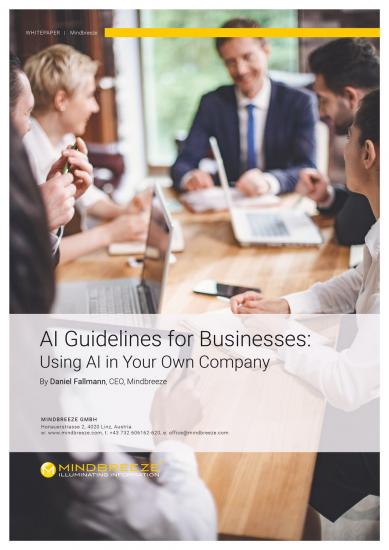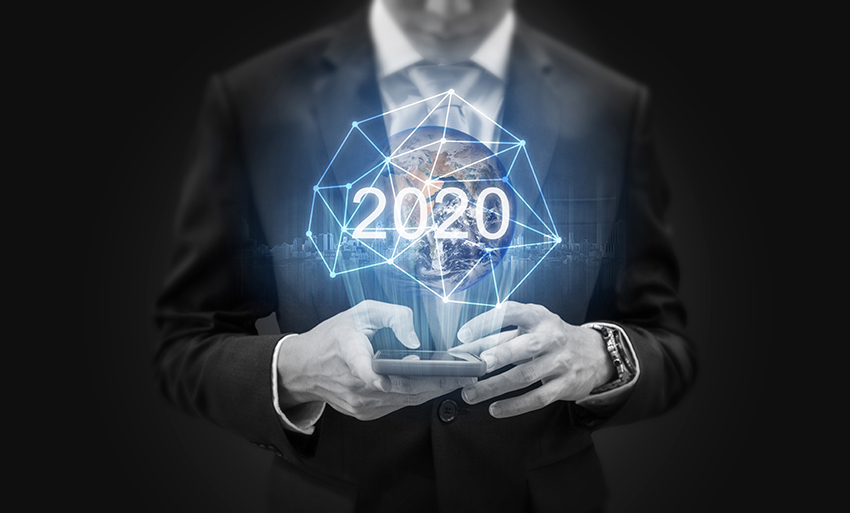Trends for 2020 – Insight engines: transformation engines with a human touch
The digital transformation imposes tough demands on every company, no matter what their size or which industry they serve. More than anything else, the speed at which decisions have to be made has increased dramatically in recent years. This means that the companies that understand how to process their data so that they can actually leverage it any time and anywhere as a real basis for decision-making are the companies that will reap competitive advantages. In this article, Daniel Fallmann, founder and CEO of Mindbreeze, illustrates how much significance insight engines have already gained in this field today and which trends are emerging for the year 2020.
1. Bundling information, generating knowledge
People often refer to corporate data as the gold of the 21st century. This portrayal is largely incorrect and, in fact, irresponsible, since it encourages people to settle for merely collecting data. The result: Data volumes that are ballooning by the day end up scattered in hundreds of silos throughout the company and play only a minor role in digital transformation.
We can hardly refer to the data as gold until businesses process and refine this raw material by correlating their data and generating actual knowledge from it. Experts describe this process as connecting the dots. The process is also comparable with the neuronal connections in the human brain.
Insight engines handle the refinement intelligently and independently. By placing a layer, as it were, over all the information silos within a company, all the data – whether structured or unstructured – is linked together. This can be used to develop a winning strategy that determines how data is collected, stored, cleaned, managed, secured, used, and analyzed, and how the data impacts the business. By the end of this cycle, you end up with nothing less than concentrated knowledge that is available to the entire company.
So the real message is: The gold of the year 2020 is the automated generation of knowledge across all departmental boundaries.
2. New findings fuel the digital transformation
With an advanced level of automation, fast-growing companies in particular can do more than conserve valuable resources that have been tied up in manual data entry or maintenance. Insight engines also deliver completely new discoveries that can be harnessed for digital change.
One typical area of application is marketing. Pattern recognition of needs or early detection of new trends will help to attract and retain customers. Similarly, in the area of research and development, subject matter experts can be identified quickly based on specific patterns and then contacted so they can apply their expertise specifically to similar research projects.
In 2020, companies and organizations will increasingly recognize the impact that insight engines have on digital transformation, which will pave the way for new business opportunities.
3. Made-to-measure knowledge instead of information overflow
From the millions of sensations that humans are exposed to every second, our brains subconsciously filter out all the information that isn’t necessary to cope with everyday life. In other words, the brain focuses on the essential.
In most cases, conventional knowledge management methods used by companies today are miles away from this ideal situation. Thousands of hits for every web search or an endless list of documents when searching in file systems are symptomatic of the current state of affairs.
By contrast, insight engines are designed to process information on the basis of the different roles and positions in the company in a way that ensures that only information relevant to the particular function or question can pass through the filter. One typical use case is in the area of customer care or first level support. Employees can access exactly the information they need at the touch of a button and efficiently provide support or answer customer questions. What’s more, the longer the system is in use, the better the customized filter works.
In 2020, the trend towards providing personalized content at exactly the right time will gain considerable momentum.
4. Natural human–machine interaction
We’ve been working with monitors and keyboards in the digital world for decades and we’ve gotten very used to it. According to Gartner, this unnatural way of interacting has an expiration date. By next year, as much as 30 percent of all web browsing and searches will already be handled using auditory technologies. On top of that, according to the market research institute, a whopping seven billion devices will have voice-controlled assistants.
Leading insight engines have been relying on voice control for quite some time; Mindbreeze calls its technology, which makes natural human–machine interaction possible, the “Conversational Platform.” The technologies behind this include Natural Language Processing (NLP) and Natural Language Question Answering (NLQA) as well as the semantic processing of content.
Besides the ability to communicate in natural language, leading-edge insight engines provide intelligent ways to visualize information, which facilitates comprehension as well as long-term memory retention. To this end, Mindbreeze offers so-called search applications, which – with their user-friendly configuration and visual processing of the results – can really make an impact.
In 2020, insight engines will play a major role in the “Voice First Revolution” advocated by Gartner, as well as in the trend towards increased visualization of data or search results.
5. Hyperautomation instead of busy work
Many companies today are exploring the topic of Robotic Process Automation (RPA) in order to utilize AI and machine learning to complete repeatable tasks that previously had to be performed by humans. In other words, the objective is to free up human resources from tedious routine work and steer them towards more critical or creative tasks.
But that’s just the beginning. Gartner is already talking about “hyperautomation.” This is where a number of tools, including RPA, and various automated processes are correlated and harmonized. By the end of this journey we typically end up with the digital twin of an organization (DTO), which enables companies to visualize the interplay of functions, processes, and KPIs in order to maximize value creation.
Since the high integration capability of insight engines applies not only at the data level but also at the process level, they can provide crucial impetus to the trend towards hyperautomation in 2020.
6. Insight engines become a constant companion
According to Gartner, by 2022, 40 percent of employees will consult AI agents before making decisions in day-to-day business.
Conventional softwarebots can’t handle this task because, in reality, they don’t have anything to do with AI and only operate according to a manually created and stored decision tree.
Conversely, insight engines can take advantage of the strengths of real AI. In 2020, employees will thus increasingly use this forward-looking technology to fill the role of a personal assistant.
7. Regulated coexistence
There are innumerable systems in place – from ethical principles to legislation – that regulate human coexistence. The more human-like these digital entities behave, the more necessary it is to impose the same strict criteria on human–machine interaction.
The ongoing dialogue about where the limits of modern technology lie and how we should address the issues of security, liability, data sovereignty, and privacy has only just begun. This means that in 2020, we will inevitably have to view the discourse as a task for society as a whole, and bring together all stakeholders – from policymakers to academia – at one table.
The bottom line: The “humane” transformation engine
Insight engines have become a major driver of digital transformation in recent years. The added value they bring runs the gamut from data refinement and knowledge generation to the support of hyperautomation.
Another key characteristic of the digital transformation is that modern technologies need to be more accurately geared toward the needs of the people. And here again, insight engines will play to their strengths in 2020.
 How the successful integration of these technologies succeeds and also achieves the desired success can be read in our white paper "AI guidelines for businesses":
How the successful integration of these technologies succeeds and also achieves the desired success can be read in our white paper "AI guidelines for businesses":
Download White Paper
Latest Blogs
Inside Insight: How Journeys and Touchpoints Make Enterprise Search Effortless with Mindbreeze Insight Workplace
Picture this: you’re preparing for a high-stakes client meeting.
The Future of Enterprise AI Depends on Smarter RAG Solutions
Today’s enterprise leaders ask how to make AI meaningful, responsible, and scalable. One architectural approach stands out as organizations look beyond isolated proof-of-concepts and begin embedding AI into workflows: Retrieval-Augmented Generation (RAG).


